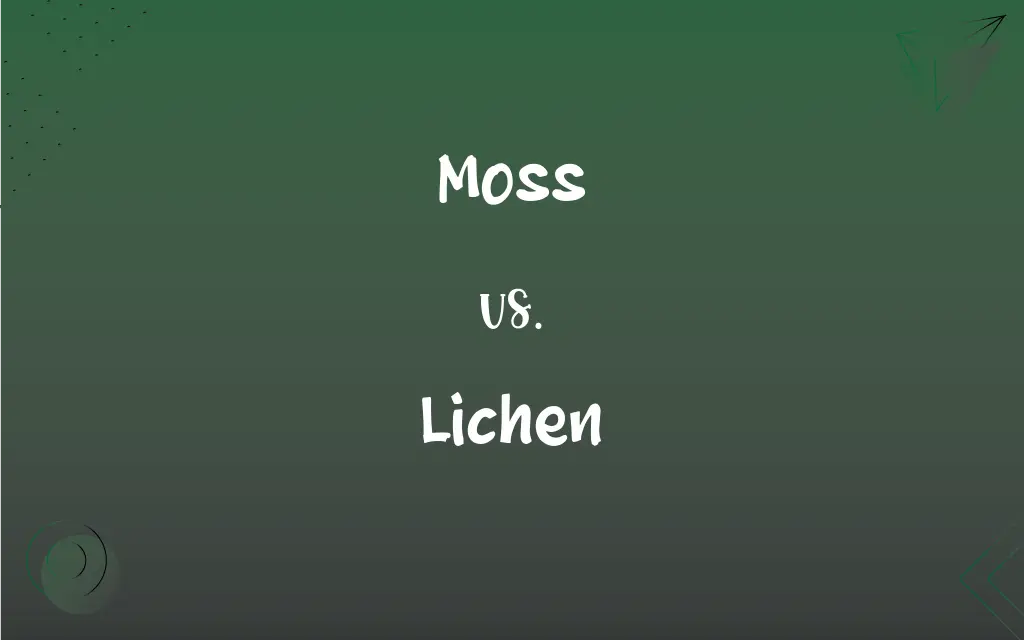Moss vs. Lichen: What's the Difference?
Edited by Aimie Carlson || By Janet White || Published on December 18, 2023
Mosses are small, green, non-vascular plants, while lichens are symbiotic associations between a fungus and a photosynthetic partner, usually algae or cyanobacteria.

Key Differences
Mosses are simple, non-flowering plants belonging to the Bryophyta division. They typically form dense green mats or clumps in damp or shady locations. Lichens, however, are complex organisms that arise from the symbiotic relationship between fungi and a photosynthetic partner, usually algae or cyanobacteria, each providing essential services to the other.
In mosses, the dominant life stage is the gametophyte, which is green and photosynthetic. Mosses absorb water and nutrients mainly through their leaves and are known for their resilience and ability to colonize harsh environments. Lichens, in contrast, are renowned for their ability to survive in extreme conditions, from arctic tundra to hot deserts, due to their unique symbiotic nature.
Mosses reproduce both sexually, through spores, and asexually, by fragmentation. They play a critical role in ecosystems, such as providing habitat for microfauna and contributing to soil formation. Lichens are important ecological indicators, sensitive to environmental changes, particularly air quality, and contribute to the weathering of rocks and soil formation.
The structure of moss is relatively simple, with root-like rhizoids, a stem, and leaves, but no true roots, stems, or leaves like in vascular plants. Lichens have a more complex structure, often described in terms of the fungal component, which forms the majority of the lichen's body, and the photosynthetic component, which lies within the fungal tissues.
Mosses require a moist environment for survival and growth, while lichens can withstand severe dehydration and resume normal function when rehydrated. This difference underscores the diverse adaptations of these two distinct types of organisms in their respective habitats.
ADVERTISEMENT
Comparison Chart
Biological Classification
Non-vascular plants (Bryophyta)
Symbiotic association of fungus and algae/cyanobacteria
Structure
Simple structure with rhizoids, stem, leaves
Complex structure with fungal and photosynthetic components
Habitat
Damp, shady environments
Wide range, including extreme conditions
Reproduction
Sexual (spores) and asexual (fragmentation)
Mostly asexual, through fragmentation
Ecological Role
Habitat for microfauna, soil formation
Environmental indicators, soil and rock weathering
ADVERTISEMENT
Moss and Lichen Definitions
Moss
Plants reproducing through spores and often found in damp locations.
The old stone wall was covered in a thick layer of moss.
Lichen
A combination of fungi and algae/cyanobacteria living together.
Lichens contribute significantly to the ecosystem of the tundra.
Moss
Small, green, non-vascular plants that form dense clumps or mats.
The forest floor was carpeted with soft, green moss.
Lichen
Organisms known for surviving in harsh environmental conditions.
Lichens were the only life forms present on the rocky mountain face.
Moss
Bryophyte plants known for their moisture-loving nature.
Moss thrives on the north side of trees where moisture lingers.
Lichen
Hardy, composite organisms playing a role in soil formation.
Lichens on the forest floor were slowly breaking down the rocks into soil.
Moss
Simple plants without true roots, absorbing water through leaves.
Mosses covering the rocks near the stream added to the serene beauty.
Lichen
Unique organisms used as indicators of air quality and pollution.
Environmental scientists used lichens to monitor the air quality in the forest.
Moss
Non-flowering plants forming lush, green mats in shady areas.
The moss garden provided a tranquil, verdant escape.
Lichen
Symbiotic organisms composed of fungi and a photosynthetic partner.
The tree bark was adorned with various colorful lichens.
Moss
Any of various green, usually small, nonvascular plants of the division Bryophyta, having leaflike structures arranged around the stem and spores borne in a capsule.
Lichen
A composite organism made up of a fungus, usually an ascomycete, that grows symbiotically with an alga or a cyanobacterium and characteristically forms a crustlike or branching growth on rocks or tree trunks.
Lichen
(Medicine) Any of various skin diseases characterized by patchy eruptions of small, firm papules.
Lichen
To cover with lichens.
Lichen
Any of many symbiotic organisms, being associations of algae and fungi, often found as white or yellow-to-blue–green patches on rocks, old walls, etc.
Lichen
(figurative) Something which gradually spreads across something else, causing damage.
Lichen
One of a class of cellular, flowerless plants, (technically called Lichenes), having no distinction of leaf and stem, usually of scaly, expanded, frond-like forms, but sometimes erect or pendulous and variously branched. They derive their nourishment from the air, and generate by means of spores. The species are very widely distributed, and form irregular spots or patches, usually of a greenish or yellowish color, upon rocks, trees, and various bodies, to which they adhere with great tenacity. They are often improperly called rock moss or tree moss.
Lichen
A name given to several varieties of skin disease, esp. to one characterized by the eruption of small, conical or flat, reddish pimples, which, if unchecked, tend to spread and produce great and even fatal exhaustion.
Lichen
Any of several eruptive skin diseases characterized by hard thick lesions grouped together and resembling lichens growing on rocks
Lichen
Any thallophytic plant of the division Lichenes; occur as crusty patches or bushy growths on tree trunks or rocks or bare ground etc.
FAQs
Are mosses considered primitive plants?
Yes, they are primitive due to their simple structure.
Where do mosses commonly grow?
In damp, shady environments like forests and wetlands.
Are lichens a single organism?
They are a composite of at least two organisms.
How do mosses reproduce?
Through spores and asexually by fragmentation.
Do lichens need soil to grow?
No, they can grow on surfaces like rocks and tree bark.
Are lichens important in ecosystems?
Yes, they play a role in nutrient cycles and as pioneer species.
How do lichens reproduce?
Mainly asexually, through fragments or soredia.
Can mosses grow on rocks and trees?
Yes, they often grow on rocks, trees, and other surfaces.
Are mosses ever harmful?
Rarely, but they can be slippery on walkways.
What is moss?
Small, green, non-vascular plants forming dense mats or clumps.
What types of surfaces do mosses prefer?
Moist, shaded surfaces like wood, soil, and stone.
What is a lichen?
A symbiotic association between a fungus and a photosynthetic partner.
Where can lichens be found?
In a variety of environments, including extreme ones.
Can lichens be used to monitor environmental health?
Yes, they are sensitive to air pollution and climate change.
Can lichens grow indoors?
It's rare, as they require specific environmental conditions.
Is moss gardening popular?
Yes, moss gardens are valued for their beauty and tranquility.
Can lichens survive in urban areas?
Yes, but they are more sensitive to air pollution.
What ecological role do mosses play?
They contribute to soil formation and provide habitat for microfauna.
How do lichens contribute to soil formation?
By breaking down rocks and adding organic matter.
Do mosses have roots?
No, they have root-like structures called rhizoids.
About Author
Written by
Janet WhiteJanet White has been an esteemed writer and blogger for Difference Wiki. Holding a Master's degree in Science and Medical Journalism from the prestigious Boston University, she has consistently demonstrated her expertise and passion for her field. When she's not immersed in her work, Janet relishes her time exercising, delving into a good book, and cherishing moments with friends and family.
Edited by
Aimie CarlsonAimie Carlson, holding a master's degree in English literature, is a fervent English language enthusiast. She lends her writing talents to Difference Wiki, a prominent website that specializes in comparisons, offering readers insightful analyses that both captivate and inform.







































































